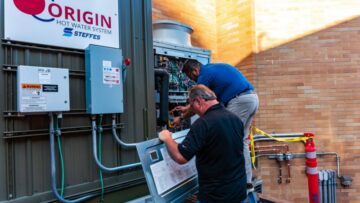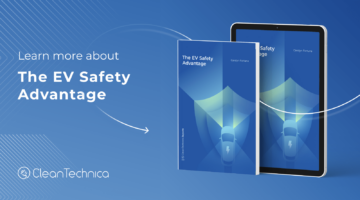Sign up for daily news updates from CleanTechnica on email. Or follow us on Google News!
The idea seems kooky at first glance, but the race to launch an orbiting solar power plant into space is heating up, with the US and the UK both in the running. In the latest news, a UK startup with the ambitious name of Space Solar anticipates that a demonstration model of their device will be orbiting within the next three years, beaming solar energy down to a receiver on Earth 24/7, regardless of the weather. If you’re thinking that similar technology could be applied to remote EV charging, read on.
Actually, Space Solar Is Not Kooky
CleanTechnica caught up with the latest US space solar news back in January, when we noted that solar energy in space is not a new thing. After all, the pricey orbiting solar arrays of the 1950s paved the way for the low-cost earthbound solar innovations of today.
As for why the space-to-Earth connection is taking so long, we also took note of obstacles including “scale, cost, the delicate maneuvering required to unfurl a solar array in space, and the ability of the solar cells to withstand the tough outer space environment, including solar flares and geomagnetic activity.”
“NASA also notes that space solar arrays would need to maintain a geostationary orbit, which means they would be located farther out in space than conventional satellites,” we added.
Space solar research continues apace at the California Institute of Technology, which has been making good use of a $100 million grant received by the school from the philanthropists Donald and Brigitte Bren. In January, the CalTech research team completed an in-space test run of three foundational technologies, including a batch of 32 different kinds of solar cells.
Although NASA has taken a wait-and-see stance on space solar, other federal agencies, including the US Naval Research Laboratory, and possibly the US Space Force, have been contributing to the cause along with Grumman and other private sector partners (catch up on CleanTechnica’s space solar coverage here).
UK Startup Sets Ambitious Space Solar Target
Space solar activity is also humming along in the UK. The latest news comes from the Oxfordshire startup Space Solar, which announced a proof-of-concept breakthrough in February. The company’s Co-CEO, Sam Adlen, also affirmed that the goal is to send a technology demonstration into orbit within the next three years, towards delivering a “meaningful” level of power from space to Earth sometime around 2030.
“The UK’s leading space-based solar power (SBSP) company, Space Solar, today announces the results of a detailed engineering design and analysis study which confirms the performance characteristics for its CASSIOPeiA Solar Power Satellite concept,” the company said of itself in a press statement dated February 7.
Space Solar describes its technology as significantly different from other iterations, particularly in terms of the all-important financial profile as well as its ability to deliver clean kilowatts on a continuous, 24/7 basis. They list structure, thermal management, attitude and orbit control, photovoltaics and light path” among the key design features that contributed to the achievement of performance and mass targets.
“Initial findings from the company’s HARRIER wireless power transmission demonstrator have also fed into the study, and helped to optimise the design,” the company reported.
Baby Steps For Space Solar …
Last week, the Belfast Telegraph was among those reporting that Space Solar has successfully tested a prototype of its CASSIOPeiA technology at Queen’s University in Belfast.
“The tests in Belfast have now shown the system to work for the first time, with a wireless beam successfully ‘steered’ across the lab to turn on a light,” the Telegraph reported.
Telegraph reporter also took note of the number of rocket launches — about 68 — required to assemble the full-scale, mile-wide solar array in orbit.
If that sounds expensive, it is. However, the cost of a rocket launch has been dropping precipitously in recent years, and further declines are anticipated.
… Are You Thinking What We’re Thinking?
The choice of Queen’s University for high profile test of the technology was no accident. Researchers at Queen’s have been hammering away at the space solar effort under the school’s “Wireless Power Transfer for Space-based Solar Power” program.
“Queen’s researchers have produced two major innovations for BVLOS (Beyond Visual Line of Sight) WPT: beyond near/far field auto-focusing antenna array technology, and orientation agnostic rectifying antenna (rectenna) systems,” Queen’s reports, referring to control systems for controlling drones even when out of eyesight.
“This know-how can be applied to bring energy remotely to satellites in constellations and HAPS [high altitude platform stations], from space-based solar power farms to Earth, or to electric vehicles in space settlements,” the school adds.
Wait, did they just say electric vehicles in space settlements? Yes, they did.
If space solar could be applied to electric vehicles on Earth, that could lead to the introduction of EVs with minimal requirements for onboard batteries, reducing the environmental impacts of mining, manufacturing, and other lifecycle issues related to EV batteries.
That’s purely speculative, of course. However, Queen’s University was the lead research organization on a 2019 UKRI (UK Research and Innovation) grant aimed at developing a long-distance, high-power wireless system for use on Earth.
Back then, the researchers noted that much of the work on wireless systems was focused on medium-power microwave transmission, suitable for sensors and other low-power applications.
The high-power angle could lead to “disruptive” applications, including in smartphones, “or even electric vehicles,” the team noted.
“Higher powered WPT can be carried out using low frequency inductive coupling techniques, although range is very short (<20 cm). Therefore we see microwave WPT, as the only way of breaking the barrier of longer distance and higher power,” they explained.
As originally conceived, the program would culminate in two significant demonstrations, one involving laboratory measurements and the other involving an actual long-duration VOTL (vertical take-off and landing) drone flight.
Next Steps For Space Solar
The grant period closed last September with no further press announcements from the school. CleanTechnica is reaching out to see if a recap is available, and we’ll be sure to ask if the drone technology could be transferred to ground transportation.
In the meantime, researchers at another UK Institution, Queen Mary University of London, received a grant of £960,000 to investigate the use of a new phased array transmitter for wireless power transmission in space solar applications.
“A phased array is a system of multiple antennas that work together, enabling the beam to be directed and focused in a desired spot,” Queen Mary University explains.
“The team will also demonstrate high Radio Frequency (RF) to DC conversion efficiency in an offset-fed reflector-based rectenna, which plays a vital role in capturing and converting the transmitted energy,” the school adds, referring to a device that converts electromagnetic waves to a DC electrical current electricity.
The team plans to construct a small-scale demonstration device to validate the concept, so stay tuned for more on that.
Follow me @tinamcasey on Bluesky, Threads, Post, and LinkedIn.
Image (cropped): “A view from inside MAPLE, which will demonstrate wireless power transmission in space. This angle shows both the array of flexible, lightweight microwave power transmitters (right side), and the two receivers that they will transmit power to (left side). The top receiver is receiving power in this picture, and it is lit by this wirelessly transmitted power,” courtesy of CalTech.
Have a tip for CleanTechnica? Want to advertise? Want to suggest a guest for our CleanTech Talk podcast? Contact us here.
Latest CleanTechnica TV Video
[embedded content]
Advertisement
CleanTechnica uses affiliate links. See our policy here.
- SEO Powered Content & PR Distribution. Get Amplified Today.
- PlatoData.Network Vertical Generative Ai. Empower Yourself. Access Here.
- PlatoAiStream. Web3 Intelligence. Knowledge Amplified. Access Here.
- PlatoESG. Carbon, CleanTech, Energy, Environment, Solar, Waste Management. Access Here.
- PlatoHealth. Biotech and Clinical Trials Intelligence. Access Here.
- Source: https://cleantechnica.com/2024/04/07/space-solar-really-really-is-not-so-spacey-any-more/
- :has
- :is
- :not
- $100 million
- $UP
- 000
- 20
- 2019
- 2030
- 32
- 400
- 7
- a
- ability
- About
- AC
- accident
- achievement
- across
- activity
- actual
- added
- Adds
- Advertise
- Affiliate
- After
- agencies
- aimed
- All
- along
- also
- Although
- ambitious
- among
- an
- analysis
- and
- angle
- announced
- Announcements
- Announces
- Another
- antenna
- Anticipated
- anticipates
- any
- applications
- applied
- ARE
- around
- Array
- AS
- ask
- At
- attitude
- available
- away
- back
- barrier
- basis
- batteries
- BE
- Beam
- been
- Beyond
- bluesky
- both
- Breaking
- breakthrough
- brigitte
- bring
- but
- by
- california
- CAN
- Capturing
- carried
- Catch
- caught
- Cause
- Cells
- characteristics
- charging
- choice
- clean
- cleantech
- Cleantech Talk
- closed
- CO
- Co-CEO
- comes
- company
- Company’s
- Completed
- conceived
- concept
- connection
- construct
- content
- continues
- continuous
- contributed
- contributing
- control
- controlling
- conventional
- Conversion
- converting
- converts
- Cost
- could
- course
- courtesy
- coverage
- Current
- dated
- dc
- Declines
- deliver
- delivering
- deloitte
- demonstrate
- demonstration
- describes
- Design
- desired
- detailed
- developing
- device
- DID
- different
- directed
- distance
- donald
- down
- drone
- drone technology
- Drones
- Dropping
- earth
- effort
- Electric
- electric vehicles
- electricity
- embedded
- enabling
- energy
- Engineering
- Environment
- environmental
- EV
- EV batteries
- Even
- evs
- expensive
- explained
- Explains
- Farms
- Features
- February
- Fed
- Federal
- field
- financial
- findings
- First
- first time
- flexible
- flight
- focused
- For
- foundational
- Frequency
- from
- full-scale
- further
- Glance
- goal
- good
- grant
- Ground
- Guest
- harrier
- Have
- helped
- High
- higher
- However
- HTML
- HTTPS
- idea
- if
- Impacts
- in
- Including
- Innovation
- innovations
- inside
- Institute
- Institution
- into
- Introduction
- investigate
- involving
- issues
- IT
- iterations
- ITS
- itself
- January
- jpg
- just
- Key
- kinds
- lab
- laboratory
- landing
- Last
- latest
- Latest News
- launch
- launches
- lead
- leading
- left
- Level
- lifecycle
- light
- lightweight
- Line
- links
- List
- located
- London
- Long
- longer
- Low
- low-cost
- maintain
- major
- Making
- management
- manufacturing
- Maple
- mary
- Mass
- max-width
- me
- means
- meantime
- measurements
- million
- minimal
- Mining
- model
- more
- much
- multiple
- name
- Nasa
- Need
- New
- news
- next
- no
- note
- noted
- Notes
- now
- number
- obstacles
- of
- on
- Onboard
- ONE
- only
- optimise
- or
- Orbit
- orbiting
- organization
- originally
- Other
- our
- out
- outer space
- particularly
- partners
- paved
- performance
- period
- Phased
- picture
- plans
- plant
- platform
- plato
- Plato Data Intelligence
- PlatoData
- player
- plays
- podcast
- policy
- possibly
- Post
- power
- powered
- press
- private
- private sector
- Produced
- Profile
- Program
- prototype
- purely
- queen
- Race
- range
- reaching
- Read
- really
- recap
- received
- receiving
- recent
- reducing
- referring
- Regardless
- related
- remote
- remotely
- Reported
- reporter
- Reporting
- Reports
- required
- Requirements
- research
- research and innovation
- researchers
- Results
- right
- rocket
- Role
- Run
- running
- Said
- Sam
- satellite
- satellites
- say
- School
- sector
- see
- seems
- send
- sensors
- September
- Sets
- Settlements
- Short
- shown
- Shows
- side
- Sight
- significant
- significantly
- similar
- smartphones
- So
- solar
- Solar cells
- solar energy
- Solar Power
- sounds
- Space
- space-based
- speculative
- Spot
- stance
- startup
- Statement
- Stations
- stay
- Steps
- structure
- Study
- Successfully
- suggest
- suitable
- sure
- system
- Systems
- taken
- taking
- Talk
- targets
- team
- techniques
- Technologies
- Technology
- terms
- test
- Test run
- tests
- than
- that
- The
- the UK
- their
- then
- therefore
- thermal
- they
- thing
- Thinking
- this
- those
- three
- time
- tip
- to
- today
- together
- took
- top
- tough
- towards
- transfer
- transferred
- transmission
- transmit
- transmitters
- transportation
- tuned
- TURN
- tv
- two
- Uk
- under
- university
- Updates
- us
- use
- uses
- using
- VALIDATE
- Vehicles
- vertical
- very
- Video
- View
- visual
- vital
- want
- was
- waves
- Way..
- we
- Weather
- week
- WELL
- What
- when
- which
- why
- will
- wireless
- with
- within
- Work
- work together
- would
- years
- yes
- you
- youtube
- zephyrnet








